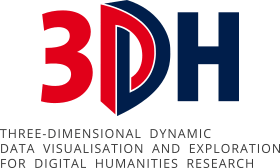Johanna Drucker gave a special lecture on June 6th that reported on the state of the project and where we are going. She started by giving some history to the 3DH project. We went from “create the next generation of visualizations in the digital humanities?” to a more nuanced goal:
Can we augment current visualizations to better serve humanists and, at the same time, make humanistic methods into systematic visualizations that are useful across disciplines outside the humanities?
She commented that there is no lack of visualizations, but most of them have their origins in the sciences. Further, evidence and argument get collapsed in visualization, something we want to tease apart. In doing this, can we create a set of visualization conventions that make humanities methods useful to other disciplines? Some of the things important to the humanities that we want to make evidence include: partial evidence, situated knowledge, and complex and non-singular interpretations.
Project development is part of what we have been focusing on. We have had to ask ourselves “what is the problem?” We had to break the problem down, agree on practices, frame the project, and sketch ideas.
Johanna talked about how we ran a charette on what was outside the frame. She showed some of the designs. Now we have a bunch of design challenges for inside the frame. One principle we are working with is that a visualization can’t be only data driven. There has to be a dialogue between the graphical display and the data. Thus we can have visualization driven data and vice versa.
We broke the tasks down to:
- Survey visualization types
- Study pictorial conventions
- Create graphical activators
- Propose some epistemological / hermeneutical dimensions
- Use three dimensionality
- Apply to cases
- Consider generalizability
Visualization Types
Johanna then went through showed the typology we are working with:
- Facsimiles are visual
- XML markup also has visual features, as do word processing views
- Charts, Graphs, Maps, Timelines
- 3D renderings, Augmented realities, Simulations
- Imaging techniques out of material sciences
Graphical Activators
She talked about graphical primitives and how we need to be systematic about the graphical and interactive features we can play with. What can we do with different primitives? What would blurring mean? What happens when we add animation/movement, interactivity, sound?
With all these graphical features, then the question is how can we combine the activators with interpretative principles.
Using the 3rd Dimension as Interpretation
She then talked about how we can use additional dimensions to add interpretation. She showed some rich examples of how a chart could be sliced and projected. We can distort to produce perspectives. The graphical manipulation lets us engage with the data visually. You can do anamorphic mapping that lets us see the data differently.
She then talked about perspectivization – when you add a perspective to the points. You dimensionalize the data. You add people to the points. Can we use iconography?
She showed ideas for different problems like the hairball problem. She showed ideas for how visualizations that are linked can affect each other. She showed ideas for the too much Twitter problem.
She talked about the problem of how to connect different ideological taxonomies for time like biblical and scientific time without collapsing them? How can we show the points of contact without reducing one to the other?
She then talked about the issue of generalizability. Can we generalize the ideas she has been working with? How can we humanize the presentation of data? Can we deconstruct visualizations?
Some of the questions and discussion after her talk touched on:
- To what extent are visualizations culturally specific?
- Does adding more graphical features not just add more of the same? Does it really challenge the visualization or does it add humanistic authority?
- How is adding more dimensions a critique of display rather than just more display?
- We talked about the time of making the visualization and the time of the unfolding of the visualization.
- We talked about how time can represent something or model something.
- Can we imagine games of making visualizations? How does the making of the visualization constitute a visualization? Can a way of making visualizations be more useful?
- How can any visualization have the APIs to be connected to physical controls and physical materializations?

